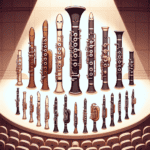Introduction to Clarinet Playing for Beginners
For anyone who's ever dreamed of playing the clarinet, getting started can feel as exciting as it is challenging! If you're a beginner, knowing where to start and what to focus on can make all the difference. This guide shares practical tips to help you build a strong foundation in your clarinet journey.
Handling Your Clarinet with Care
Let's start by discussing how to handle your clarinet properly. Many new players don't realize how important it is to put the instrument together correctly. Always gently twist the parts together, using the bridge key as your guide. If you rush or force the pieces, you might damage the instrument. Trust me, you don't want to deal with repairs when you're just starting out!
The Importance of Proper Posture
Your posture plays a big role in how well you play. Sit or stand up straight, and keep your shoulders relaxed. Good posture isn't about being stiff as a board; it's about finding a comfortable position that doesn't restrict your breathing. Think of yourself as a tree – strong but flexible. If your posture is off, playing will be harder, and you'll get tired quickly.
Breathing Techniques for Clarinet Players
Breathing is super important when playing the clarinet. Did you know that how you breathe can change your tone and how long you can play? Try breathing from your diaphragm. Imagine filling your belly with air instead of your chest. Take a deep breath in, and let it out slowly and steadily. This might feel weird at first, but you'll get used to it with practice.
| Breathing Technique | Description | Benefit |
|---|---|---|
| Diaphragmatic Breathing | Breathe into your belly, not your chest | Improves tone and endurance |
| Controlled Exhalation | Steady, consistent air flow | Better control over notes and dynamics |
| Quick Inhalation | Fast, deep breath between phrases | Allows for longer playing without breaks |
Choosing the Right Reed
Now, let's talk about the reed – it's small, but it's a big deal! New players often have trouble finding the right reed strength. Start with a softer reed, usually a size 1.5 or 2. This makes it easier to produce a sound. Wet the reed before you put it on your mouthpiece – this helps it seal better and vibrate smoothly when you play. Don't forget to replace old or damaged reeds to keep your sound consistent. Many players like to pair their clarinets, like the well-made Martin Freres models, with good reeds to get that rich, full sound.
Developing Your Embouchure
Learning how to shape your mouth on the mouthpiece (that's your embouchure) is super important when you're starting out. Put the reed against your bottom lip, roll your lip slightly over your teeth, and close your lips gently. Don't bite or clamp down. Instead, think about sipping through a straw. Your embouchure might feel weird at first, but stick with it. Even players who've been at it for years are always working on their embouchure.
Mastering Finger Placement
Let's chat about where to put your fingers. Get to know the holes and pads on your clarinet. Keep your fingers relaxed and a bit curved, and make sure they cover the tone holes completely. New players often leave gaps between their fingers and the holes, which can cause squeaks. Try to keep consistent pressure with your fingers and don't move them more than you need to.
Tuning Your Clarinet
Using a tuner when you practice is super helpful for new clarinetists. Tuners help you stay in tune and train your ear to hear pitch differences. Tuning can be tricky, especially when the temperature or humidity changes. Even well-made clarinets like Martin Freres models can be affected by these things. You can adjust your pitch by giving the barrel a little twist.
Playing in a Group
Joining a group for beginners is a great idea. Playing with others teaches you how to listen and stay in time. When you're new, it really helps to see and copy what other players are doing. Plus, making music together is a great confidence booster!
Taking Care of Your Clarinet
Don't forget to take care of your clarinet! Get into the habit of cleaning the inside of your instrument after every time you play to get rid of moisture. If you don't, it can start to smell bad or make the pads sticky. Keep an eye on the corks and keys for wear and tear too. Good clarinets, like those made by Martin Freres, last a long time when you take care of them properly.
Setting Up a Practice Routine
Creating a practice routine is really important. Start with short practice sessions of 15-20 minutes every day instead of long, tiring ones. When you're learning something new, it's better to practice a little bit often than a lot all at once. Always start with warm-ups: scales, long notes, and breathing exercises should be part of every practice. Trust me, doing these basics over and over is what will make you a better player in the long run.
Embracing Mistakes
Lastly, don't worry about making mistakes. New players often get upset about squeaks or missed notes, but that's all part of learning. Every professional clarinet player, even those who play fancy Martin Freres Clarinets, started out making squeaks and struggling. Think of mistakes as learning opportunities and ask for feedback from teachers or other musicians.
Conclusion
Starting to play the clarinet can be exciting, scary, and everything in between. These tips should give you a good place to start. Remember, every great clarinet player was once a beginner too. If you're patient, curious, and practice good habits, you'll not only get better, but you might find a lifelong love for this amazing instrument.
Table of Contents
- Introduction to Clarinet Playing for Beginners
- Handling Your Clarinet with Care
- The Importance of Proper Posture
- Breathing Techniques for Clarinet Players
- Choosing the Right Reed
- Developing Your Embouchure
- Mastering Finger Placement
- Tuning Your Clarinet
- Playing in a Group
- Taking Care of Your Clarinet
- Setting Up a Practice Routine
- Embracing Mistakes
- Conclusion







